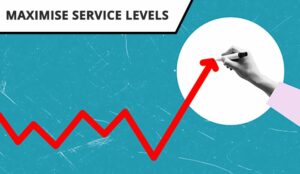Improving service level in your call centre comes down to aligning your team’s technology and actions with your objectives. You need to know where you currently stand, where you intend to go and what it will take to get there.
The good news is that these details are not too tough to figure out and the reward for doing so is well worth the effort. However, many call centres stumble in trying to take charge of their service levels.
What makes improving your service level so elusive is a lack of understanding of its purpose and an over-emphasis on improving specific call centre KPIs, like average handle time (AHT) to compensate. By getting call centre managements detail right, you can create a virtuous cycle for both your agents and your customers.
Defining Service Level Within Your Call Centre
Service level is a unique type of metric used to measure roughly how many of the calls you receive over a given stretch of time are answered within a specified minimum amount of time.
The number of calls received and answered is generally represented as a percentage of your call centre’s total quantity of incoming calls. As for the minimum amount of time agents have to answer those calls, that depends on your call centre’s needs and long term goals.
Normally, many call centres aim for an answering speed of about 20 seconds for roughly 80% of all the calls they have coming in.
Measuring and Benchmarking Your Call Centre’s Service Level
There are multiple ways that service level can be calculated. Measuring your existing service level provides a useful benchmark for measuring progress over time.
The first way to calculate service level is simply to divide the number of calls received per period by the number of calls currently on the line and multiply by 100%. This is a great way to get started measuring service level as it keeps the entire calculation relatively simple.
However, service level can also account for the lost calls to provide a clearer picture of your team’s performance.
A good formula intended to include lost call information in the final result subtracts calls over a maximum length threshold from the total number of calls on the line, then proceeds with the same division and multiplication steps outlined in the previous formula.
Improving the Service Level in Your Call Centre
Your call centre’s service level can be improved over time by taking a closer look at the people and processes you currently have in place to support it.
Both the tools you and your agents use, such as conversation intelligence software, as well as the interactions you have with each agent in your team tie into the resulting service level your centre achieves.
Below are some tips to tackle both the technological and interpersonal aspects of improving your call centre’s service level.
Technological Tactics
Try a more comprehensive scheduling system – Scheduling can make or break your call centre’s capacity to serve its customers.
In fact, understaffing and overstaffing both have the potential to undermine your team’s efforts to please customers by either stretching minimal staff too thin or expending resources on agents with nothing to do during their shifts.
You can begin to crack the scheduling code by implementing minor improvements such as allowing for more flexible schedules and employing additional part-time workers.
Doing these and more with an automated system can help you to keep track of timing and optimize agent availability to match customer needs.
Leverage real-time management – A real-time management solution provides you with the kind of immediate insight into your current processes that you need to keep them aligned.
For instance, it can help you see any sudden deviations from your established forecast for your current time period and isolate the cause at a glance.
Interpersonal Approaches
Define your omnichannel customer service approach upfront – Map out a comprehensive approach to customer service that accommodates all of your customers’ needs to the best of your ability with flexible scripts and accommodating procedures.
Hire the right people – This may seem like a no-brainer, but it takes great agents to get great results in any call centre. If your agents are willing to work at improving their answering speeds and issue-resolving skills, then you are already close to achieving an ideal service level.
Optimizing your call centre’s service level does more than deliver a new batch of impressive metrics to your organization’s higher-ups.
The higher your service level, the more satisfied your customers. An excellent service level is a good indicator of your team’s competence, confidence and ability to resolve customers’ calls in a reasonable amount of time.
This blog post has been re-published by kind permission of CallMiner – View the Original Article
For more information about CallMiner - visit the CallMiner Website
Call Centre Helper is not responsible for the content of these guest blog posts. The opinions expressed in this article are those of the author, and do not necessarily reflect those of Call Centre Helper.
Author: CallMiner
Published On: 12th Apr 2022
Read more about - Guest Blogs, CallMiner






 CallMiner is the leading cloud-based customer interaction analytics solution for extracting business intelligence and improving agent performance across all contact channels.
CallMiner is the leading cloud-based customer interaction analytics solution for extracting business intelligence and improving agent performance across all contact channels. 












